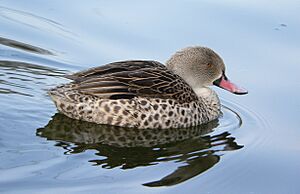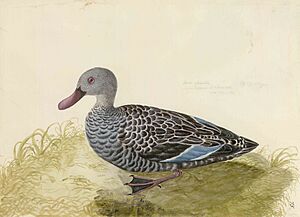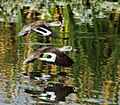Cape teal facts for kids
Quick facts for kids Cape teal |
|
|---|---|
 |
|
| Conservation status | |
| Scientific classification | |
| Genus: |
Anas
|
| Species: |
capensis
|
The Cape teal (Anas capensis) is a cool duck that lives in wetlands across sub-Saharan Africa. It's also sometimes called the Cape wigeon. These ducks are about 44–46 centimeters long, which is roughly the size of a small house cat. They are known as dabbling ducks because they feed by tipping their bodies forward in the water, rather than diving completely.
Contents
Discovering the Cape Teal
The Cape teal was officially described by a German scientist named Johann Friedrich Gmelin in 1789. He put it in the same group as other ducks, geese, and swans, which is called the Anas genus. He gave it the scientific name Anas capensis.
Gmelin used information from an English bird expert, John Latham, who had described the "Cape widgeon" in 1785. Latham had a special watercolor painting of the teal. This painting was made by Georg Forster in 1773, when he was traveling with Captain James Cook on his second trip around the world. Forster drew the duck near the Cape of Good Hope in Africa.
This original painting is now kept at the Natural History Museum in London. It's called the holotype, which means it's the main example used to define the species. The name Anas comes from the Latin word for a duck. The word capensis means "from the Cape," referring to the Cape of Good Hope. This duck species does not have different types or subspecies.
What Does the Cape Teal Look Like?
Cape teals are quite pale and mostly grey. Their backs are a bit browner. They have a pink color on their bills, but young birds don't have this pink yet. Unlike many other ducks, the male and female Cape teals look very similar.
These ducks are usually quiet. However, during mating season, the males make a clear whistle. The females have a soft "quack." It's easy to tell the Cape teal apart from other ducks in the areas where it lives.
Where Do They Live?
Cape teals don't usually migrate long distances. They tend to stay in the same general area. However, they will move to new places if there's more rain and better water conditions.
You won't often see huge groups of Cape teals. They are spread out across their habitat. Sometimes, you might see large groups of up to 2,000 ducks when they are moulting, which is when they shed their old feathers.
What Do They Eat?
The Cape teal finds its food by dabbling in the water. This means they tip their heads and bodies forward, reaching for food just below the surface. They eat aquatic plants and small creatures. Their diet includes tiny invertebrates, crustaceans, and small amphibians.
When it's time to build a nest, they choose a spot on the ground. The nest is usually hidden under plants and close to water.
The Cape teal is an important bird. It is protected by an agreement called the Agreement on the Conservation of African-Eurasian Migratory Waterbirds (AEWA). This agreement helps protect waterbirds that travel between Africa and Eurasia.
Gallery












